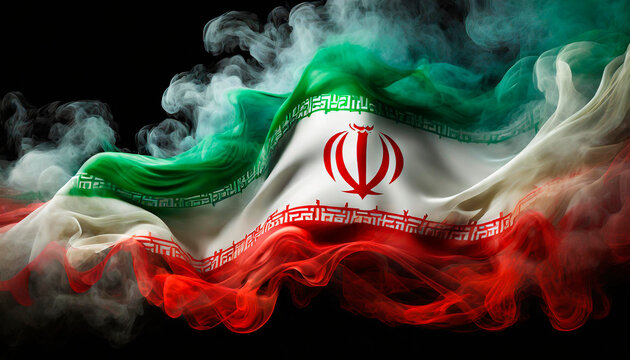The Symbolism of the Iran Flag: A Deep Dive into Its History and Meaning

The flag of Iran is not just a mere symbol of a nation; it embodies the country’s history, cultural identity, political ideologies, and religious beliefs. The tricolor of green, white, and red, along with the distinctive emblem at the center, carries deep symbolism that reflects the spirit of the Iranian people, their struggles, and their aspirations. In this article, we will explore the history of the Iran flag, its evolution, the symbolism behind its design, and how it reflects the nation’s identity.
A Brief History of the Iran Flag
To understand the symbolism of the Iran flag, we must first trace its history. Iran, historically known as Persia, has had several different flags since the early periods of its history. Each iteration of the flag has served as a reflection of the changing political climates, cultural values, and ruling dynasties.
Early Flags of Persia
The early flags of Persia were simple in design, often reflecting royal symbols and coats of arms. The Achaemenid Empire, which ruled from 550 to 330 BCE, used a standard that featured a figure of the king or a divine figure. The Parthian and Sassanian periods saw the use of various animal motifs, including the lion and the eagle, symbolizing power and imperial authority.
The Qajar Dynasty (1789–1925)
Under the Qajar Dynasty, Persia adopted its first standardized national flag in the 19th century. The flag consisted of three horizontal stripes in green, red, and white, with the central stripe bearing a lion and sun motif—a symbol of monarchy and strength. This flag remained in use until the early 20th century, though the lion was removed from the flag after the Constitutional Revolution in 1906.
The Pahlavi Era (1925–1979)
The Pahlavi dynasty introduced a new flag in 1932. This version of the flag retained the green, white, and red color scheme but replaced the lion and sun emblem with a simple, stylized version of the national emblem—a more modern, nationalistic symbol that reflected the modernization efforts of Reza Shah Pahlavi.
Post-Revolutionary Flag (1979–Present)
After the Iranian Revolution of 1979, which led to the establishment of the Islamic Republic of Iran, the flag underwent its most significant transformation. The new flag consisted of three horizontal bands—green on top, white in the middle, and red on the bottom—with an Islamic emblem in the center. This emblem features a stylized depiction of the word “Allah” and is surrounded by a symbolic arrangement of geometric shapes. The new flag was officially adopted on July 29, 1980.
The Design of the Iran Flag
The design of the Iranian flag consists of three horizontal bands: green at the top, white in the middle, and red at the bottom. Each of these colors carries significant symbolism, and the emblem in the center further enriches the flag’s meaning.
The Green Stripe: The Color of Islam and Growth
The top band of the Iran flag is green, a color that holds deep significance in both Islam and Iranian culture. In Islamic tradition, green is often associated with paradise and is considered the color of the Prophet Muhammad’s banner. It also symbolizes fertility, prosperity, and growth.
For Iranians, green is a reminder of their deep Islamic roots and the role of religion in shaping their national identity. Additionally, it is linked to the concept of renewal and a connection to the natural world, representing the growth of the Islamic Republic of Iran after the revolution.
The White Stripe: The Color of Peace and Unity
The middle stripe of the flag is white, symbolizing peace, unity, and the aspiration for a harmonious society. White is often regarded as the color of truth and purity in many cultures, and in the context of the Iranian flag, it serves as a call for national unity among Iran’s diverse ethnic and religious groups.
The white also symbolizes the Iranian people’s desire for a peaceful existence, both within their borders and with other nations.
The Red Stripe: The Color of Courage and Sacrifice
The bottom band of the flag is red, a color that represents courage, sacrifice, and the bloodshed of those who fought for the freedom and independence of Iran. Red has long been a symbol of revolution, struggle, and the determination of the Iranian people to preserve their sovereignty and independence. This color connects the flag to Iran’s turbulent political history, including the sacrifices made during the Islamic Revolution of 1979.
The Emblem: A Symbol of Islamic Ideology
At the center of the Iranian flag is an emblem that combines elements of Islamic calligraphy and geometric design. The emblem represents a stylized version of the word “Allah” (God) and incorporates four crescents and a sword. This emblem has significant religious, political, and philosophical connotations.
The four crescents represent the four major Shia branches of Islam, while the sword signifies the readiness of the Iranian people to defend their nation and religion. The emblem also reflects the ideological foundation of the Islamic Republic of Iran, emphasizing the central role of Islam in the country’s identity and governance.
The Symbolism of the Iran Flag in Modern Times
In the modern political context, the Iran flag has become an enduring symbol of the country’s Islamic revolution and the government that arose from it. The flag’s design reflects the Islamic Republic’s commitment to upholding the principles of Shia Islam, as well as its emphasis on independence and resistance to foreign influence.
In the context of diplomacy, the flag is a source of pride for the Iranian people and a tool of national representation. It appears at international events, embassies, and government buildings, reinforcing Iran’s place in the global community.
Cultural and Social Significance
Beyond its political and religious symbolism, the Iran flag plays a vital role in Iranian culture. It is a symbol of national pride and unity, often displayed during significant national holidays, such as Revolution Day on February 11 and National Army Day on April 18. During these occasions, citizens come together to honor their country’s history, culture, and the sacrifices made for national sovereignty.
The flag is also seen at sporting events, particularly when Iranian athletes compete on the international stage. It represents not just political ideology but also the unity of the Iranian people, regardless of their ethnic or religious backgrounds.
The Iran Flag and Its Role in National Identity
The flag of Iran is deeply intertwined with the nation’s identity. From the history of the Persian Empire to the Islamic Republic, the flag has constantly evolved to reflect the values and ideals of each period in Iranian history. Today, the Iran flag remains a powerful symbol of the nation’s aspirations for peace, justice, and cultural pride.
It is a reminder of the revolutionary changes that have shaped the country, and a symbol of hope for a future rooted in Islamic values, unity, and progress. The Iranian people, through their flag, continue to express their collective identity, aspirations, and resistance against any forces that threaten their sovereignty.
Frequently Asked Questions (FAQs)
- What does the Iran flag represent?
The Iran flag symbolizes the country’s Islamic identity, political revolution, and national unity. The green represents Islam, the white signifies peace, and the red symbolizes courage and sacrifice. The emblem at the center represents the Islamic faith and readiness to defend the country.
- What is the significance of the emblem on the Iran flag?
The emblem of the Iran flag represents a stylized version of the word “Allah” and features four crescents and a sword. It reflects the Islamic foundation of the Iranian government, the defense of the country, and the unity of Shia Islam.
- Why did the Iran flag change after the 1979 revolution?
After the 1979 Islamic Revolution, Iran transitioned from a monarchy to an Islamic republic, and the flag was redesigned to reflect the country’s new political and religious values. The emblem was introduced to symbolize the Islamic ideology of the revolution and the new regime.
- What do the colors of the Iran flag mean?
The green represents Islam and growth, the white stands for peace and unity, and the red symbolizes courage, sacrifice, and the bloodshed during Iran’s revolutionary struggles.
- How has the Iran flag evolved?
The Iran flag has evolved from simple royal banners during the Achaemenid Empire to the current design introduced after the 1979 revolution. Each version has mirrored the political changes in the country, from monarchy to revolution and the establishment of the Islamic Republic.
You May Also Read: https://usasmartnews.com





